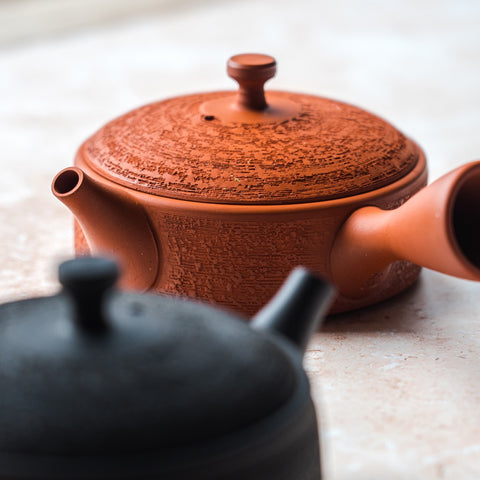





Japanese Matcha Bowl - Kintsugi Kairagi Glazed O-ido Chawan - 300ml
This product is no longer available
This beautiful Ido chawan (matcha bowl) is made in the O-ido (大井戸 - large Ido) style, and as such has a roughly conical shape and a very tall bamboo node-shaped foot (竹の節高台 - takenofushi koudai). Like most great Ido chawan, this bowl exhibits glaze crawling called 'kairagi' (かいらぎ/梅花皮 - plum flower texture) on and around its foot. This unique glaze texture is highly praised among Ido chawan collectors.
Once damaged, this chawan has been repaired with red urushi lacquer — a more subdued form of kintsugi that is befitting of Ido chawan. This style of repair was famously used on the Tsutsu-i-zutsu (筒井筒) Ido chawan that was owned by Toyotomi Hideyoshi
Kintsugi (金継ぎ - gold joinery) is a ceramic repair technique in which chips, cracks, and broken pieces are repaired with urushi lacquer, which is either mixed or dusted with precious metal powder, typically gold or silver. Rather than hiding the damage, the use of precious metals highlights the flaws, which tells the story of the item’s wear and repair over time, and ties into the Buddhist concept of mushin (無心 - no mind) which embraces such imperfection.
The technique and philosophy of kintsugi has long been associated with chanoyu (茶の湯) or the Japanese tea ceremony, where it has been used on many famous pieces. The earliest examples were often repaired with simple black or red urushi lacquer, which is less ornate and more wabi or humble. Though the technique of lacquer repair dates as far back as the Jomon period, it was supposedly first introduced to the tea room by Furuta Oribe (古田織部) in the late 16th to early 17th century.
Ido chawan (井戸茶碗 - well tea bowl) is the name given to a certain type of Joseon-era Korean bowls and pieces made in their likeness. The original 16th century Korean bowls were first made as humble rice and food bowls for peasants, but when they made their way to Japan, their simple ash glazes and subtly uneven shapes drew the eye of tea masters, making them one of the most coveted styles of matcha bowl, as Japanese tastes moved away from the perfection and ostentation of Chinese celadon and Tenmoku bowls, to a more rustic and modest aesthetic, called wabi.
The original Korean Ido chawan can be roughly sorted into three main shapes: 大井戸/O-ido (large Ido), 小井戸/Ko-ido (small Ido), and 青井戸/Ao-ido (blue Ido). O-ido bowls, like the legendary Kizaemon Ido, are large with a tall bamboo node-shaped foot (竹の節高台 - takenofushi koudai), a warm beige biwa/loquat coloured glaze, with slightly curved but roughly conical-shaped walls. Ko-ido bowls are similar, but smaller with a less pronounced foot. Ao-ido bowls also have shorter feet and have much straighter, conical walls without the gentle curve seen in O-ido bowls. The 'blue' in their name may come from the colder glaze colour that many of these bowls have.
Dimensions:
13.4cm (5.3in) - width
8.5cm (3.3in) - height
300ml - capacity
Condition: Very good
This vintage Japanese item ships from Thailand





